A History of American Agriculture 1776 - 1990 Farm Machinery and Technology
16th - 18th Centuries - Oxen and horses for power, crude wooden plows, all sowing by hand, cultivating by hoe, hay and grain cutting with sickle, and threshing with flail
1790's - Cradle and scythe introduced
1834 - McCormick reaper patented, John Lane began to manufacture plows faced with steel saw blades.
1837 - John Deere and Leonard Andrus began manufacturing steel plows.
1837 - Practical threshing machine patented.
1841 - Practical grain drill patented
1842 - First Grain elevator, Buffalo NY
1844 - Practical mowing machine patented
1847 - Irrigation begun in Utah
1856 - 2-house straddle-row cultivator patented
1865-75 Gang plows and sulky plows came into use
1868 - Steam tractors were tried out
1869 - Spring-tooth harrow and seedbed preparation appeared
1870's - Silos came into use
1874 - Glidden barbed wire patented
1880 - William Deering put 3,000 twine binders on the market
1884 - 1890 - Horse-drawn combine used in Pacific coast wheat areas.
1890-1895 Cream separators came into wide use.
1910 - 1915 - Big open-geared gas tractors came into use in areas of extensive farming
1915-20 - Enclosed gears developed for tractors
1918 - Small prairie-type combine with auxiliary engine introduced
1926 - Successful light tractor developed
1930's - All-purpose, rubber-tired tractor with complementary machinery came into wide use.
1945 - 70 - Change from horses to tractors and the adoption of a group of technological practices characterized the second American agricultural revolution.
1954 - Number of tractors on farms exceeded the number of horses and mules for the first time.
Late 1950's - 1960's - Anhydrous ammonia increasingly used as cheap source of nitrogen, spurring higher yields.
1965 - 5 labor-hours required to produce 100 bushels ( 3 1/3 acres) of wheat with tractor, 12-foot plow, 14-foot drill, 14-foot self-propelled combine and trucks.
1965 - 5 labor-hours required to produce 100 pounds (1/5 acre) of lint cotton with tractor, 2-row stalk cutter, 14-food disk, 4-row bedder, planter and cultivator, and 2-row harvester .
1970's - No-tillage agriculture popularized
1980's - More farmers used no-till or low-till methods to curb erosion.
1989 - After several slow years, the sale of farm equipment rebounded.
1989 - More farmers began to use low-input sustainable agriculture (LISA) techniques to decrease chemical applications.

